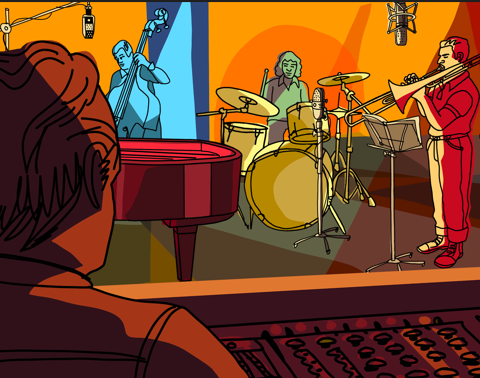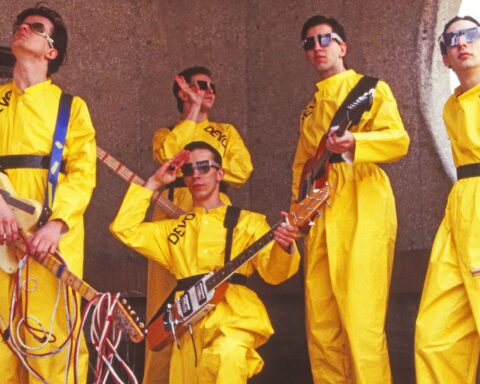The speaker’s hair may be white but he has the casual air of a younger, hipper man. Behind him we can recognize the features of a recording studio: a mixing board with white sliders and a glass wall that separates the control room from the “live room” where singers and players do their thing. Clearly this man is a producer or engineer, someone dedicated to the alchemical art of preserving moments of musical genius so that they may savoured for generations to come.
There’s sadness in his voice as he speaks of an artist’s debut album and the expectations it engendered. “At that time he had all the machinery in place–big names, big money behind it. Circumstances were right. Why didn’t it make it? That’s the big question. Today it still haunts me.”
He’s followed a few minutes later by another wizened sage of the music biz, who expresses a similar degree of ruefulness as he lounges in his Palm Springs abode. “This guy deserves recognition,” says the man, emphasizing each word. “Nobody in America had even heard of him—nobody was even interested in listening to him…. How could that be?”
You may need to change the gender from male to female or the singular form for solo artist to the plural for band. But these scenes and these sentiments could’ve been found in any number of recent documentaries about talented artists either consigned to footnote status in musical history or, like Sixto Rodriguez, the subject of the bittersweet recollections shared by producers Mike Theodore and Steve Rowland, barely known at all.
These are underdog tales of people whose ambitions were thwarted and whose gifts went unacknowledged due to a variety of factors, though the nefariousness of the music industry is a common theme. And yet in an impressive number of cases, the films about them have not only brought these artists wider renown, they’ve won Oscars too. A crowd-pleaser about backup vocalists who have struggled to claim centre stage for themselves, 20 Feet from Stardom won the Academy Award for best documentary feature in 2014. A film that reveals the strange saga of Rodriguez and his return to music upon learning of his massive (and massively unlikely) fame in South Africa, Searching for Sugar Man won the same prize the previous year. (Sadly, that triumph was overshadowed by the news of director Malik Bendjelloul’s suicide in May of 2014.)
Both docs belong to a growing category of feature-length studies of the almost famous. Indeed, they may be evidence of a full-fledged boom for unabashed displays of music geekery. At the very least, this urge by filmmakers to sing the praises of the unsung doesn’t seem as strange as it once did. Over the course of the seven years that producer Danielle McCarthy spent working on Big Star: Nothing Can Hurt Me, about the ill-fated Memphis power-pop band that influenced R.E.M., the Replacements and countless others, she noticed the shift in people’s perceptions of her quest.
“People used to look at me like, ‘Oh, you’re making a documentary about a band that no one’s heard of?’” says McCarthy. “They’d look at me as if to ask, ‘Why are you doing that?’ Now it’s like, ‘Of course you’re making a movie about a band no one’s heard of.”
It’s not that the famous are so hard done by in the wide world of music documentaries. Be it Martin Scorsese on Bob Dylan, Peter Bogdanovich on Tom Petty, or Jonathan Demme on Pearl Jam and Neil Young, major filmmakers continue to demonstrate a keen interest in their guitar-slinging peers. Nor is there a shortage of movies examining the creation of epochal long-players such as Michael Jackson’s Bad (in Spike Lee’s Bad 25) or Paul Simon’s Graceland (in Joe Berlinger’s Under African Skies).
Yet stories of lesser-known acts have gained equal or sometimes greater prominence. Inevitably, they invite us to scrutinize a very diverse roster of figures. Some films reveal the lives of outsiders too idiosyncratic or troubled to ever crack the mainstream (e.g., Daniel Johnston in The Devil and Daniel Johnston, Wild Man Fischer in Derailroaded). Then there are the many should’ve-beens who failed to match expectations despite heaps of hype and talent: consider the sad case of openly gay glam rocker Jobriath in Jobriath A.D.
In other films, artists must overcome personal travails and addictions to get their first or sometimes second stab at success, like Pentagram singer Bobby Liebling in Last Days Here or the titular subject in the bio-pic Charles Bradley: Soul of America. Or else their work is too innovative or courageous for their era and is only fully appreciated years later, like Arthur Russell in Wild Combination: A Portrait of Arthur Russell or Death in A Band Called Death. A forthcoming movie by American Hardcore director Paul Rachman, Lost Rockers, may trump all of the aforementioned efforts with its profiles of eight (!) different artists unfairly consigned to history’s dustbin, including the Velvet Underground’s Doug Yule and original “Tainted Love” singer Gloria Jones.
If there’s a single film that heralds the current trend, it’s Louie Bluie, an affectionate portrait of country-blues artist Howard Armstrong that Terry Zwigoff released in 1985. In spending five years (and exhausting his life savings) to make a movie about an artist known only to a few hardcore blues collectors, the future Crumb auteur demonstrated the crate-digger sensibility that’s so prevalent today.
Indeed, such is the surge of interest in musical also-ran stories that many narrative filmmakers have followed suit. Joel and Ethan Coen cribbed much of Inside Llewyn Davis from the memoir of Greenwich Village folkie Dave Van Ronk. Meanwhile, the British comedy Frank draws its inspiration from the stranger-than-fiction story of the papier-mache-headed pop oddball known as Frank Sidebottom.
No wonder it can feel like every one-or-no-hit wonder that ever entered a soundproof booth may soon have a big-screen tribute. The challenge, as always, is making films that will be compelling to viewers who aren’t already part of the artist’s cult of admirers.
“I do think that there are a lot of films being made about obscure bands right now that don’t offer much more than exposure to the band’s music,” says Jeff Wright, who programmes music docs for the CMW Film Festival in Toronto. “The best films about music have not just amazing music, but also fascinating personalities or stories. As documentaries about undiscovered talents continue to grow in popularity, so does the number of documentaries about bar bands who are friends with the film’s director.”
Inevitably, the products of all this enthusiasm can sometimes feel homogenous, as if they were many variations on the same sad tale of gifted artists who were denied their rightful places in music history due to obstacles both external and self-generated. Yet in their varied quests to belatedly cast a spotlight on their subjects, filmmakers have used a wide array of tactics and strategies, and that’s as true of the Oscar winners as it is of scrappier examples. While Searching for Sugar Man mixes aspects of an Errol Morris–style investigation with the story of a humble man getting his due, 20 Feet from Stardom punctuates its heartstring-tugging profiles with thrilling performances and testimonials from rock luminaries like Mick Jagger.
The fact that both these films had so much success is no surprise to Reginald Harkema, the Toronto-based editor and filmmaker whose credits include docs on the New Pornographers (Better Off in Bed) and Alice Cooper (Super Duper Alice Cooper, co-directed with Sam Dunn and Scot McFadyen). Says Harkema of the films that found favour with Academy voters, “They are documentary as Hollywood feel-good story: the unjustifiably unrecognised finally get recognised. It appeals to the American sense of truth and justice.”
Indeed, it may be hard to see what connects such eagerly inspirational fare to films like Jandek on Corwood, a far moodier profile of one of American underground music’s most enigmatic figures. But even the more mainstream examples still feel like the work of music fans who are eager to share their passions in the hopes that their enthusiasm will be infectious.
“There is definitely an evangelical urge to share your tastes,” says Harkema. “If you are going to invest the time and labour a documentary takes, you better be into the music.”
Having discovered Big Star through ’90s-era descendants like Teenage Fanclub, Danielle McCarthy says she was driven by the fervour that marks a true music fan. “We definitely felt like we needed to spread the gospel,” she says. “Foremost in our minds was getting the story told and getting people to be more aware of the music. There was always the more typical indie music fan who of course knows the Big Star history but we really wanted to get it out further.”
McCarthy and director Drew DeNicola also believed that the tragic arc of the band’s career, as well as the many personal demons that imperiled its two singer-songwriters Alex Chilton and Chris Bell, was sufficiently rich for the story to have a wider appeal.
In the case of Wild Combination and director Matt Wolf, the sheer unlikelihood of Arthur Russell’s story was enough to spark the filmmaker’s fascination. “I was really interested in Arthur’s story when somebody described him to me as a ‘gay disco auteur from Oskaloosa, Iowa,’” says Wolf of the cellist and composer who also became a significant figure in New York’s experimental music community before dying of AIDS in 1992.
In addition to becoming a passionate fan of Russell’s music, Wolf soon realized that the musician’s saga intersected with the larger histories of gay culture and the avant-garde art scene in New York. Indeed, the wider circumstances of Russell’s life and times were very much reflected in his diaristic songwriting, such that Wolf felt like “the story of his life deepened the feelings in the music.”
Wolf’s desire to bring more attention to Russell’s legacy led him to modify his original plans for a more experimental film. Nor was it just about the music, as gorgeous and affecting as Russell’s is. Says Wolf, “It was also about recognizing Arthur as an important queer cultural figure and telling an intimate story about an artist that I could relate to on a personal level. I wanted people to connect to all of those things, and to think about the lives of artists in a specific way.”
Like many of the musicians featured in the current deluge of doc profiles, Russell and Big Star’s two singer-songwriters were not around to benefit from the surge of interest in their endeavours. Yet the Toronto heavy-metal band at the centre of Anvil! The Story of Anvil was able to reap the benefits of being portrayed as a real-life Spinal Tap in a hit doc. The band’s boost in profile prompted new albums by Anvil and several international tours.
“You can look at it and some people could say, ‘Hey, all you do is pick an obscure band and make a movie,’” says singer Steve “Lips” Kudlow. “It’s not quite that easy.”
Instead, he chalks up the film’s success to a unique set of factors, including the veneration the band still commanded among more famous peers like Slash and Lemmy and its long friendship with director Sacha Gervasi, who became a roadie for Anvil after meeting them at a London gig in 1982. The fact that Gervasi was fortunate enough to capture so much real-life Anvil drama on camera was another reason the film became more than a tribute best appreciated by other aging metalheads.
“It’s one thing to have gone out with all of these cameras and stuff and filmed the band, but what was going to happen?” asks Kudlow. “There was never any way to tell. It’s not as if the movie was scripted. There’s an incredible level of luck and magic that happened here.”
The prominence of movies about obscure musical acts may also be encouraging filmmakers to explore fresh takes on artists who actually succeeded. For instance, Harkema believes he underwent the same journey of discovery in making Super Duper Alice Cooper that he might have for a less famous (or infamous) subject. “Alice Cooper was an obscure figure for me,” he says. “His whole makeup/horror thing seemed like a joke. Plus, when I came of age as a music fan, he was a glam metal guy like Nikki Sixx’s ugly uncle.
“When I delved deeper I realized how much of a key cultural figure he was transitioning the ’60s to the ’70s and how underrated that original band was. Their early-’70s albums are on par with the Stones albums from that time, but not held in near as high regard. For this reason, I attacked the project with a messianic fervour, attempting to get beyond the surface level of the Alice Cooper phenomenon and trying to fix his place in rock mythology.”
It’s just as important to note that to a younger viewer with little interest in the matter of who did or didn’t make it into the musical canon, the revelations in Super Duper Alice Cooper may be as mind-blowing (and ear-shredding) as anything in recent docs on more marginal figures like Nigerian funk maverick William Onyeabor. Perhaps what matters most of all is a filmmaker’s ability to take viewers not just behind the music but deep inside the lives of those who sacrificed so much to make it.
“There are a lot of films being made right now about bands who never made it or who were screwed over by record labels,” says Jeff Wright. “Those stories are so much the norm, it’s almost a cliché. To grab an audience, you need to have a story that is unique to your subject. Really, the band or musician doesn’t even have to make good music to make a good film. They just have to have either a fascinating personality or story and be in the hands of a good filmmaker.”
Wright cites Beware of Mr. Baker, Last Days Here, Wild Combination and The Devil and Daniel Johnston as standouts in the genre. Yet, as he notes, “More important to those films than the music are the people that the films are about. One of the best music films ever made is Some Kind of Monster about Metallica, one of the biggest bands in the world and one whose music I have zero use for. But that film is incredible.”











